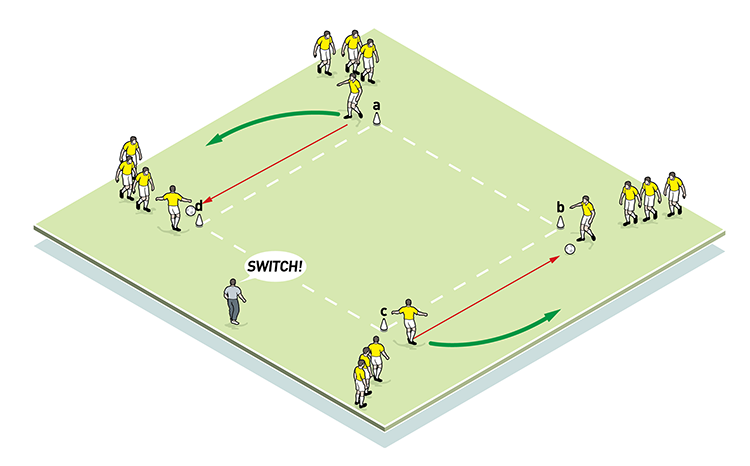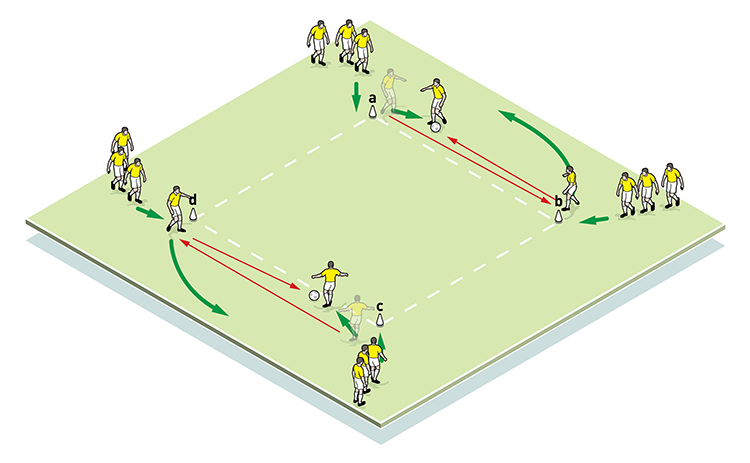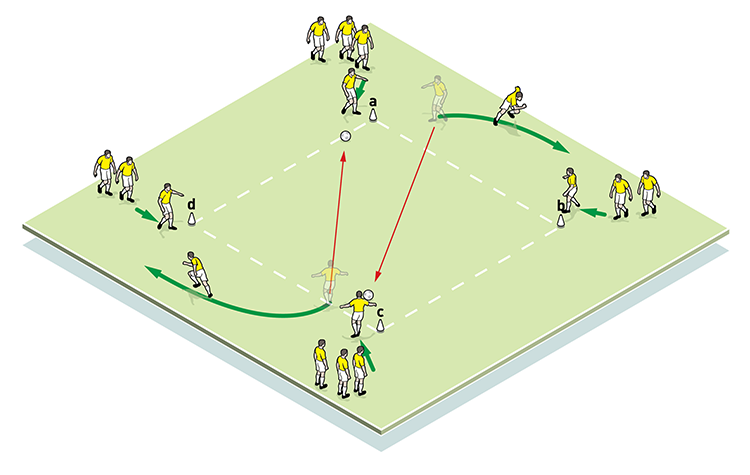The passing diamond
The passing diamond is a coaching move that, while simple in its set-up, is crucial for players in rehearsing passing accuracy and tempo. It is also important for general ball work and encouraging the use of both feet.

| Area | 8x8 yards up to 25x25 yards |
| Equipment | Cones, balls |
| No. of Players | 16 players, 4 on each cone |
The passing diamond is a coaching move that, while simple in its set-up, is crucial for players in rehearsing passing accuracy and tempo. It is also important for general ball work and encouraging the use of both feet.
Modern day football is built upon a constant passing game, so the ability to conduct simple and fast-paced passing moves has never been more important.
We work on this session three times a week, varying and changing elements so as to always keep it fresh and relevant for our players.
What do I get the players to do?
We place four players on each corner cone and begin passing using two balls, starting at the top and bottom tips of the diamond. The session is unopposed and should be up at game tempo. Passes should always be made along the floor. The ball goes clockwise from A to B, and C to D. Each player always follows his pass, joining the back of the next clockwise queue.
After every couple of minutes we will change passing direction. This ensures that mentally, players remain alert at all times, while on a practical level, they are working both feet during the exercise.
1

2

3

What are the key things to look for technically/tactically?
We encourage players to take ownership of the quality of their passes because if a pass is misplaced then one half of the entire session is delayed.
We’re also looking for players to maintain concentration despite the move’s repetition. T he first touch when receiving the ball should be outside the body, and the ball should be received on the back foot.
How do I progress the session?
The natural progression for the passing diamond is to get players passing across the playing area as well as around it. Here, A passes to B, who then sets it back to A, and a pass is made across the diamond to cone C. C and D perform the same move, with C passing across the diamond to the players on cone A. Because the original passing players A and C are on the move, the second player in the A and C cone queues is the man who receives the cross-diamond pass.
Rotate direction after each cross-diamond pass so that players on all cones are active.
We can step-up the physical requirement by asking the player who receives the ball on a cone to check, running two yards away to another marked cone before heading back to receive.
4

5

6

How would you put this into a game situation?
Construct a simple ‘keep ball’ exercise in a large playing area between two teams, 8v8. This will give them the opportunity to rehearse the basic yet essential elements of passing and ball control that they
have learned in this
practice.
Editor's Picks
Attacking transitions
Deep runs in the final third
Using the goalkeeper in build-up play
Intensive boxes drill with goals
Penetrating the final third
Creating and finishing
My philosophy
Pressing initiation
Compact team movement
Coaches' Testimonials

Alan Pardew

Arsène Wenger

Brendan Rodgers

Carlos Carvalhal

José Mourinho

Jürgen Klopp

Pep Guardiola

Roy Hodgson

Sir Alex Ferguson

Steven Gerrard
Coaches' Testimonials

Gerald Kearney, Downtown Las Vegas Soccer Club

Paul Butler, Florida, USA

Rick Shields, Springboro, USA

Tony Green, Pierrefonds Titans, Quebec, Canada
Join the world's leading coaches and managers and discover for yourself one of the best kept secrets in coaching. No other training tool on the planet is written or read by the calibre of names you’ll find in Elite Soccer.
In a recent survey 92% of subscribers said Elite Soccer makes them more confident, 89% said it makes them a more effective coach and 91% said it makes them more inspired.
Get Monthly Inspiration
All the latest techniques and approaches
Since 2010 Elite Soccer has given subscribers exclusive insight into the training ground practices of the world’s best coaches. Published in partnership with the League Managers Association we have unparalleled access to the leading lights in the English leagues, as well as a host of international managers.
Elite Soccer exclusively features sessions written by the coaches themselves. There are no observed sessions and no sessions “in the style of”, just first-hand advice delivered direct to you from the coach.









